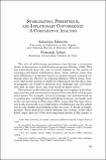| dc.contributor.author | Edwards, Sebastián, 1953- | |
| dc.contributor.author | Lefort, Fernando | |
| dc.date.accessioned | 2019-11-01T00:01:36Z | |
| dc.date.available | 2019-11-01T00:01:36Z | |
| dc.date.issued | 2002 | |
| dc.identifier.isbn | 956-7421-110 | |
| dc.identifier.uri | https://hdl.handle.net/20.500.12580/3628 | |
| dc.description | The role of inflationary persistence has become a recurrent theme in discussions on stabilization programs (Fischer, 1986). This has particularly been the case in recent debates on the merits of exchange-rate-based stabilization plans. Some authors claim that anti-inflationary programs based on predetemined nominal exchange rates are effective in reducing inflation. Others argue, however, that in the context of stub born inflationary inertia these type of programs are bound to generate real exchange rate overvaluation and, in some cases, can ever result in major crises. | |
| dc.format | .pdf | |
| dc.format.extent | Sección o Parte de un Documento | |
| dc.format.medium | p. 65-104 | |
| dc.language.iso | eng | |
| dc.publisher | Banco Central de Chile | |
| dc.relation.ispartof | Serieson Central Banking, Analysis, and Economic Policies, no. 2 | |
| dc.rights | Attribution-NonCommercial-NoDerivs 3.0 Chile | * |
| dc.rights.uri | http://creativecommons.org/licenses/by-nc-nd/3.0/cl/ | * |
| dc.subject | INFLACIÓN | es_ES |
| dc.subject | TIPO DE CAMBIO | es_ES |
| dc.subject | ESTABILIDAD ECONÓMICA | es_ES |
| dc.title | Stabilization, persistence, and inflationary convergence: a comparative analysis | |
| dc.type.doc | Artículo | |
| dc.file.name | BCCh-sbc-v02-p065_104 | |


